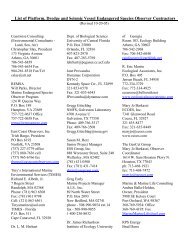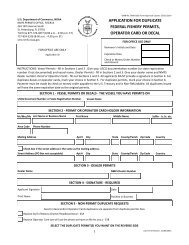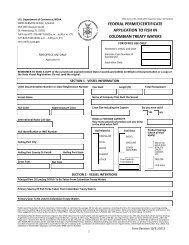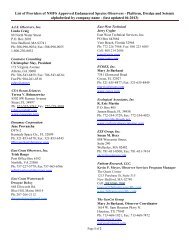NOAA Technical Memorandum NMFS-SEFSC-xxx
NOAA Technical Memorandum NMFS-SEFSC-xxx
NOAA Technical Memorandum NMFS-SEFSC-xxx
Create successful ePaper yourself
Turn your PDF publications into a flip-book with our unique Google optimized e-Paper software.
Clinical Use of Extended-Release Injectable Naltrexone in the Treatment of Opioid Use Disorder: A Brief GuideASSESSING THE NEED FOR TREATMENT Patient AssessmentA patient who is identified with a potential opioiduse disorder should undergo a thoroughassessment to confirm the diagnosis. 16 Theobjectives of the assessment are to determinethe patient’s need for treatment, to develop atreatment plan, and to establish a baselinemeasure for evaluating the patient’s progress.Accordingly, the patient assessment should:Confirm the opioid use disorder diagnosisEstablish current opioid use—when, what,and how much opioid the patient used mostrecentlyDocument the patient’s substance use history,including alcohol and other drugs of abuseIdentify patients who require medicallysupervised detoxification from alcohol,benzodiazepines, or other sedatives, inaddition to opioidsDetermine where and when suchdetoxification should be accomplishedIdentify comorbid medical and psychiatricconditions and disorders and prioritize andcoordinate their managementScreen for infectious diseases for whichpeople who misuse opioids are at elevatedrisk, such as hepatitis B , hepatitis C andHIV/AIDSAssess the patient’s access to socialsupports, family, friends, employment,housing, finances, and assistance with legalproblemsEvaluate the patient’s degree of motivation forbehavior change and readiness to participatein treatmentThe physical examination should focus onproblems the patient is experiencing andinclude screening for common consequences orco-occurring problems associated with thepatient’s current and past substance use.Substance Use History. A completesubstance use history is essential to developmentof a safe and appropriate treatment plan. 17 Indepthinterviews, combined with the use ofstandardized assessment instruments, areeffective methods of gathering this information.Ideally, the substance use history should includethe nature of the patient’s substance usedisorders, underlying or co-occurring diseases orconditions, the effect of opioid use on the patient’sphysical and psychological functioning, and theoutcomes of past treatment episodes.It is essential to find out whether the patient iscurrently taking (or recently took) methadone orother long-acting opioids. 18,19 Urine toxicologyscreens must also be completed. It also isadvisable to access the patient’s prescriptiondrug use history through the state’s prescriptiondrug monitoring program (PDMP) 20 whereavailable, both to confirm compliance in takingprescribed medications and to detectunreported use of other prescriptionmedications. 17 Information about PDMPs andhow to access them is available from stateboards of medicine and pharmacy.Information about PDMPs and how toaccess them is available from stateboards of medicine and pharmacy.In addition to securing the patient’s PDMPrecord, obtaining information from familymembers and significant others can provideuseful perspectives on the patient’s behaviorand level of function, so consent to speak withfamily members and other providers must beobtained. Contact with or records from clinicianswho have treated the patient in the past andinformation from the prescription benefitprovider should also be sought out. 10Physical Examination. The physicalexamination of a patient who is being evaluatedfor a substance use disorder should focus onphysical findings related to addiction and itscomplications. For example, examination of skininjection sites can provide useful informationabout the duration of injection drug use. Recentinjection marks are small and red and sometimesare inflamed or surrounded by slight bruising.Older injection sites typically are not inflamed butsometimes show pigmentation changes (eitherlighter or darker), and the skin may have anatrophied or sunken appearance. A combinationof recent and old injection sites suggests that the2










![Right Whale Fact Sheet [PDF] - Southeast Regional Office - NOAA](https://img.yumpu.com/28432664/1/190x245/right-whale-fact-sheet-pdf-southeast-regional-office-noaa.jpg?quality=85)


